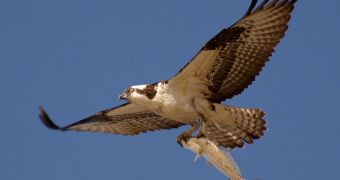Birds of prey are some of the most well-adapted animals in the world today. Over millions of years of evolution, they have had the chance to perfect their amazingly skillful talons, and diversify their use to a wide array of applications. Possible kill methods range from squeezing the prey until it gives its final breath, to dismembering the animal unfortunate enough to allow itself to get caught. Now, scientists have managed to unravel the talons' mystery, in a finding that could see them gaining new insights into how dinosaurs, the ancestors of birds, used their claws as well, LiveScience reports.
Biologists have a difficult time explaining how vicious birds of prey kill their victims even now. In spite of the fact that they have numerous observation methods at their disposal, the experts argue that getting the chance to witness a large bird eating its prey remains largely a matter of luck. Therefore, they argue, it should come as a surprise to no one that biology still has no clear clue on how talons work.
“In recent years we have been lucky enough that members of the public have been posting videos of raptor kills on YouTube – just things that they happened upon while out for a walk, or looked out into their garden to see amidst a blizzard of pigeon feathers a sparrowhawk furiously plucking away at its kill. This is fantastic data. One famous ornithologist from the 1920s said that he had only personally observed close up about 30 raptor kills his entire career,” Museum of the Rockies paleobiologist Denver Fowler says.
In the new research, more than 24 birds of prey were analyzed comparatively, based on 200 pieces of video evidence, documenting their attacks. In the case of birds such as eagles and hawks (accipitrids), it was noticed that they sported two huge claws on two of their toes, which researchers say most likely evolved to handle larger, struggling prey, and keep it in check. Most prey that these large birds capture dies on account of massive blood loss – struggling makes things worse for them – or because of massive organ failure. Most large birds eat their food while it is still alive, scientists explain.
“My favorite, the goshawk, had a humongous claw on its second toe. This was interesting to us, as dinosaurs like Velociraptor and Deinonychus also have huge claws on their second toe, so we wondered, 'what do these raptors do with this claw?' Well, after searching through the scientific literature, it turns out that no one had tried to answer that question before. In fact, no one had even noted that accipitrids even had such a strangely oversized claw, so this is what prompted us to go and find out,” the expert adds.
According to Fowler, the new data will now be used to look into possible methods of attack that dinosaurs such as Velociraptor and Deinonychus (carnivores) might have been using in their hunting strategies. Giant herbivorous sauropods such as Diplodocus may also get some scrutiny based on this information. Details of the analysis appear online, in the November 25 issue of the open-access scientific journal PLoS ONE.

 14 DAY TRIAL //
14 DAY TRIAL //